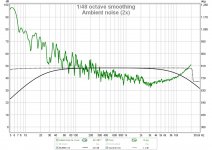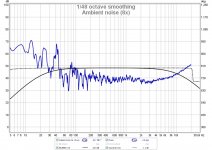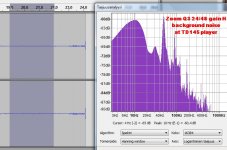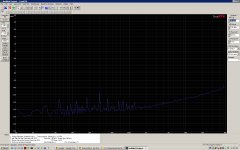Diffraction from cabinet edges and the transition from 2 Pi to 4 Pi loading are complex time domain interactions.The position of the speaker(subwoofer) and the room boundaries add to this complexity.Attempting to correct for frequency response perturbations with a single analogue cct will change phase and transient behaviour,but will do little for the supposed problem of BSC.It Is the primary effect of the SPL/ freq.response at your listening position that matters more,not the secondary event of the reverberant field intrusion.Treat diffraction at its source via proper design or ammendment and if there are room acoustic problems,use appropriate treatment.
BSC was made popular by individuals who looked at an on-axis measurement and thought 'what's that?' If one then measures round the back, they'd find all that was lost.it really is one of the major 'discoveries' that have lead to modern speaker design
question is if we have understood it fully, or if there are still things to learn about it
personally I hope there is more to learn
.... there's a groove in the couch right there where my **** fits.
heck, thats no good...means you have sunk below previous optimal listening position 😀
man, its not even a joke, really
if you sit in close to optimal listening position, the vertikal listening 'point'/position/height is way more important than anything
and I mean that, seriously
heck, thats no good...means you have sunk below previous optimal listening position 😀
😀
oh, yes, there is one thing about certain low bass tunes
they can be exstremely stimulating
and it wouldnt surprice me if they to some extent could be addictive too
but a note of caution
if they are too much out of phase they can make you really sick
and I mean that, really seriously sick
they can be exstremely stimulating
and it wouldnt surprice me if they to some extent could be addictive too
but a note of caution
if they are too much out of phase they can make you really sick
and I mean that, really seriously sick
The issue I raised was the possibility of main speaker being badly designed such that the bass quality is far from enjoyable. We all have heard people saying that "the speaker is so small but the low notes CAN BE PERCEIVED clearly/well". It is this quality which is often missing from a speaker.
About the usefulness of a sub, of course, nobody here will seriously say that it is not useful. Here it is subjective because it is about taste (that's why I have preferred not to touch the issue).
But remember, integrating subwoofer is not easy. It is almost always there is compromise. If the sub is an extra addition without compromise, then congratulation. But from all cases I have met, there are compromises.
Due to phase difference, character (speed etc) difference, the sub may ruin the main speaker frequency performance.
The need of analogue crossover is the biggest issue imo. But good if you have digital crossover.
Actually, I have a DCX and is is so bad I use it only on my bench and use an analog. Quite lucky that the subs are a foot behind the mains and it happens to be off spacing on the wall.
Diffraction from cabinet edges and the transition from 2 Pi to 4 Pi loading are complex time domain interactions.The position of the speaker(subwoofer) and the room boundaries add to this complexity.Attempting to correct for frequency response perturbations with a single analogue cct will change phase and transient behaviour,but will do little for the supposed problem of BSC.It Is the primary effect of the SPL/ freq.response at your listening position that matters more,not the secondary event of the reverberant field intrusion.Treat diffraction at its source via proper design or ammendment and if there are room acoustic problems,use appropriate treatment.
Yea, yea,. I am talking about a sub baffle maybe 16 x 22 inches so the pole is a full octave above where the crossover rolls off, the primary diffraction peak is in the mid hundreds, and I use a steep crossover. Models suggest I am well into only the 4 pi region, yet the cabinet changes seemed to make things rougher.
oh, yes, there is one thing about certain low bass tunes
they can be exstremely stimulating
and it wouldnt surprice me if they to some extent could be addictive too
but a note of caution
if they are too much out of phase they can make you really sick
and I mean that, really seriously sick
Back in school we did some "experiments" and found subsonics can cause horrible headaches, and just the right frequencies can have effects on bodily functions. With subs, I suspect one of the biggest problems is too much trying to average out the nulls, not too deep. A lot of music is really boosted as they assume weak speakers. Bad combination.
Do you mean infrasonics?Back in school we did some "experiments" and found subsonics
Not in anything I have witnessed or seen in test results. The headaches happened the next morning after when the alcohol wears off.can cause horrible headaches
Now we're getting silly. There is not one example of this that has been backed up by anything other than conjecture, assuming you are referring to the brown note?and just the right frequencies can have effects on bodily functions.
Now back to the orignal question, are subwoofers necessary?
Yes..and...No 🙂
Therefore, using a few carefully placed subwoofers, not only do we solve your issue, but we solve several others. What good reason can we possibly come up with for NOT implementing it, except for "I can't afford subs"
I have mentioned a reason.
I have owned several subs (and I still do). I have auditioned high-end subs beyond my price level in audio shops. None I have wanted to have it in my system.
So what is it again that we have solved with a sub, that we cannot do without? 20 cycles? Then we are talking about small non-critical portion of music.
And don't under estimate the added distortions from rattling windows 😀
BTW, the higher our expectation from our system, the harder we can implement a subwoofer. But if we're okay going with the mainstream, then subwoofer is a great addition. If our amp is a gainclone, adding subwoofer is not difficult. But if a SET 300B or a high speed bipolars, may be harder.
The instructions found all over the place for checking to make sure you have the same polarity on a pair of speakers have always seemed odd to me. As far as I'm concerned, it's as simple as "do these speakers sound immediately dizzying and nauseating, or not?"but a note of caution if they are too much out of phase they can make you really sick and I mean that, really seriously sick
I think I recall some workplace case study where strange complaints from workers turned out to be from very loud infrasonic noise from a large fan or something like that.. Doesn't seem terribly applicable to music reproduction, because after all, it's reproduction of something you want to experience, right?Do you mean infrasonics? Not in anything I have witnessed or seen in test results. The headaches happened the next morning after when the alcohol wears off.
As for the brown note, I also don't understand why that's such a myth, as it seems obviously plausible to me. I mean, not a magic note, but just as a thing that could happen to somebody. If you stand next to a big PA sub full-on for a while, your guts are going to vibrate, and I can certainly vouch for that sometimes not feeling so good. If you've got some intestinal disturbance going on already, I would imagine...Now we're getting silly. There is not one example of this that has been backed up by anything other than conjecture, assuming you are referring to the brown note?
Last edited:
Every smartphone is a quite good RTA analyzer, just download a free program!
For example RTA Analyzer from RadonSoft (android) has range from 20-30Hz and peak hold in free version. You can easily see spectrum and low noise from a refrigerator or air conditioning.
Or if you have a measurement system, just record and analyze "silence"!
At ambient noise levels you are getting also noise from the measuring system, but it is constant and easy to recognize.
I am sure that you will be amazed of what "silence" in your room really is!
I checked ambien noise at the corner of my room, because the vinyl player is there. There is huge peak of ambient noise at 10Hz, which is very bad because it hits the resonance of my cartridge and tonearm.
For example RTA Analyzer from RadonSoft (android) has range from 20-30Hz and peak hold in free version. You can easily see spectrum and low noise from a refrigerator or air conditioning.
Or if you have a measurement system, just record and analyze "silence"!
At ambient noise levels you are getting also noise from the measuring system, but it is constant and easy to recognize.
I am sure that you will be amazed of what "silence" in your room really is!
I checked ambien noise at the corner of my room, because the vinyl player is there. There is huge peak of ambient noise at 10Hz, which is very bad because it hits the resonance of my cartridge and tonearm.
Last edited:
I have mentioned a reason.
I have owned several subs (and I still do). I have auditioned high-end subs beyond my price level in audio shops. None I have wanted to have it in my system.
So, your reasons are pretty much "I don't want it" and "My windows rattle." and "I heard one once and I didn't think I could integrate it."
That's great, but if someone asks you "Do you think I should have one?" are you going to just say "No, because I don't like them." or will you actually attempt to qualify the question by asking necessary follow up questions, like, "What kind of music do you listen to?" and "How loud do you listen to it at?"
We get it, you use an SET amp with efficient speakers and you don't think good low bass performance is important because hardly any of the music you listened to has any low end, or you listen to it at such a feeble level that it doesn't matter anyway. That's an entirely personal thing.
I spent a couple of hours listening to music yesterday and at least half of it had content (very strong content) below 35 cycles. Would your advice to me be that I don't need subs?
I am sure that you will be amazed of what "silence" in your room really is!
So true!
“Silence” in the middle of my living room.
First screenshot is average of two measurements, second is average of eight measurements.
Each measurement has a duration of 5.9 seconds. The mic has a “C weighted” response.
I have checked it (it seems strange but it is true).
By averaging more than 4x recordings of the ambient noise in closed space, one can have the exact signature of room modes without using frequency sweeps for excitation. (Should I apply for a patent? 🙂 )
George
Attachments
So true!
“Silence” in the middle of my living room.
First screenshot is average of two measurements, second is average of eight measurements.
Each measurement has a duration of 5.9 seconds. The mic has a “C weighted” response.
I have checked it (it seems strange but it is true).
By averaging more than 4x recordings of the ambient noise in closed space, one can have the exact signature of room modes without using frequency sweeps for excitation. (Should I apply for a patent? 🙂 )
George
That's a lot of energy at 13-14 cycles, was your air handler running?
Do you mean infrasonics?
Not in anything I have witnessed or seen in test results. The headaches happened the next morning after when the alcohol wears off.
Now we're getting silly. There is not one example of this that has been backed up by anything other than conjecture, assuming you are referring to the brown note?
Now back to the orignal question, are subwoofers necessary?
Yes..and...No 🙂
Well, our testing of ulta low frequencies DID cause headaches, right then and there. Not rumor, not u-tube ( internet had not been invented ). As far as the other issue, it was the front end that seemed to be a tad more urgent than one would expect. Ultrasonics can give you a headache too, but when the sound stops, you headache does not. We were using a block wall for the diaphragm and modified compression drivers motors as the source.
Subs are necessary if you rant to listen to frequencies your mains cannot produce with sufficient level or quality. Pretty simple
"By averaging more than 4x recordings of the ambient noise in closed space, one can have the exact signature of room modes without using frequency sweeps for excitation. (Should I apply for a patent? 🙂 )"
Clever!
www.hunecke.de has very neat simulators for room modes and the effects of loudspeaker positioning! Give a try! You can move speakers and microphone 3-dimensionally in the loudspeaker sim.
Ambient noise near my turntable, measured with Zoom Q3 and "analyzed" with Audacity. That 50Hz is my PC 1m away from the mic.
Clever!
www.hunecke.de has very neat simulators for room modes and the effects of loudspeaker positioning! Give a try! You can move speakers and microphone 3-dimensionally in the loudspeaker sim.
Ambient noise near my turntable, measured with Zoom Q3 and "analyzed" with Audacity. That 50Hz is my PC 1m away from the mic.
Attachments
Last edited:
DrDayna, considering the lowest "natural" note is 32 Hz, what are you listening to? I might want to have something like that for a reference as I don't care for heavy organ. If it is electronic though, I'll pass.
I am not too far from a highway, and my sub-30 Hz noise is very high too. You don't notice it during the day, but if you sit out at night, the source becomes very clear.
I am not too far from a highway, and my sub-30 Hz noise is very high too. You don't notice it during the day, but if you sit out at night, the source becomes very clear.
Jahazi,
Well there is the 50 and harmonics popping right up there! That is really a lot of low end energy. I would think you would sense it. Traffic? Air handler? Are you sure it is not a measurement artifact? It seems pretty broad band. FFT's can do some rather odd things.
Well there is the 50 and harmonics popping right up there! That is really a lot of low end energy. I would think you would sense it. Traffic? Air handler? Are you sure it is not a measurement artifact? It seems pretty broad band. FFT's can do some rather odd things.
- Status
- Not open for further replies.
- Home
- Loudspeakers
- Multi-Way
- Subwoofers: are they really necessary for home audio?



